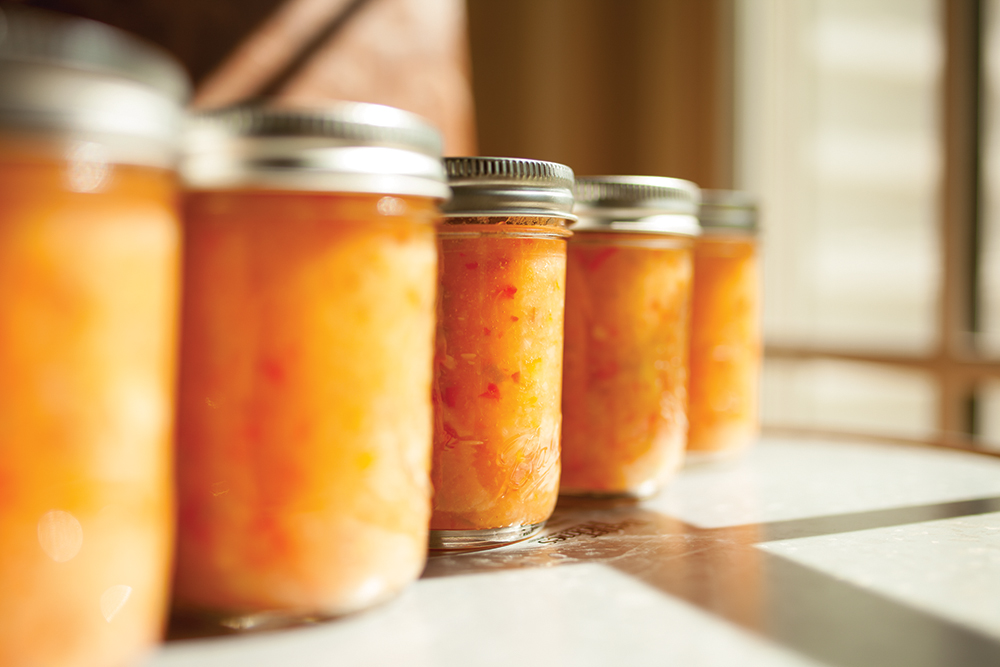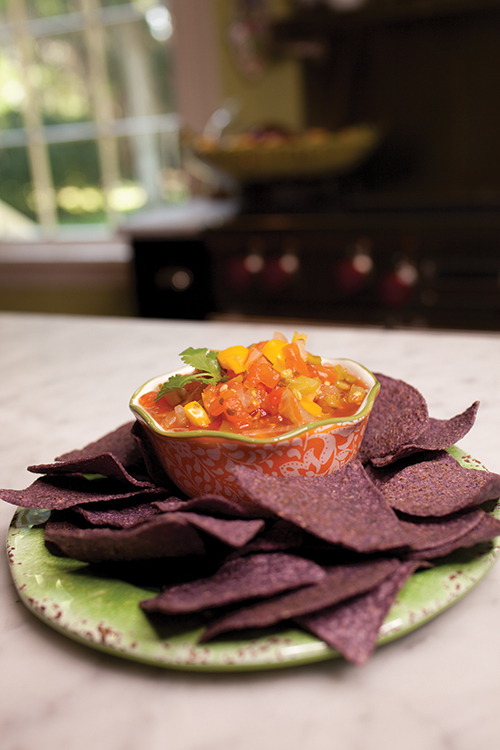
“Putting up” summer’s fresh fruits and veggies lets you savor the season longer.
In the South, the past is often present. We hold on tightly to traditions, stories, cherished heirlooms and family recipes, keeping them with us and handing them down. It’s no different with the bounty that the land gives us each summer. Most of us eat our fill of fresh produce when it’s at its peak, but those with foresight place a little bit to the side and “put it up” (by canning it) to enjoy long after green vines and tender leaves are withered and gone.
I have never been one of those people. Not because I don’t think it’s a good idea. It’s due to my phobia of food-borne illness, most specifically a slow and painful death brought on by botulism. I remember grocery shopping with my grandmother one day, and she grabbed a can of something but quickly put it right back on the shelf because it had a dent. “Never buy a dented can,” she told me. “It could have botulism.” “What’s that?” I asked. “It’s a poison that grows on food that gives you lock jaw and then you die,” she said, flatly. That was enough info for me, but she went on. “People who don’t know how to properly can at home can end having it in the jars with their preserves and pickles too.”
So, thanks to grandma, I have grown up fearing botulism like some folks are afraid of sharks or flying. I didn’t ever trust my abilities to “can properly” and so I’ve never even tried. I’ve made pickles and jams, but I always made the “refrigerator” versions, meaning I didn’t heat and seal the jars. I just placed them in the fridge and made sure to eat them (or dispose of them) within their “safe time zone,” usually a couple of weeks.
After doing the research for this article, I’ve learned that botulism is quite rare (whew!), can be treated and is only fatal in 5 to 10 percent of cases. I’ve also realized that canning is not that complicated. Following directions is key, and since I CAN read (and since my paranoia ensures I’ll execute every task to the letter), I’m looking forward to making some blackberry jam this year.
And so should you. Use one of the tasty reader-submitted recipes or that old family recipe from your favorite kitchen-savvy relative and hold on to summer’s deliciousness all year long.
-Jennifer Kornegay
Cook of the Month
Sue Robbins, Coosa Valley EC
Sue Robbins and her husband developed their recipe for pear relish after enjoying a version made by some friends. “We’d let them pick pears from our trees, and they made a relish,” she says. “We liked it but came up with our own.” They use the abundance of fresh pears their two trees yield and also turn to their yard for other ingredients. “We use peppers I grow in our garden,” Sue says. The Robbinses add the relish’s mix of sweet, tart and heat to amp up all kinds of things: vegetables like fresh field peas, meats like pork and turkey – Sue always puts some out at Thanksgiving – as well as salmon. But they like it best spooned atop a grilled hot dog.
Pear Relish
- 1 peck pears (about 15 pounds)
- 5 red sweet peppers
- 5 green sweet peppers
- 3 hot peppers
- 5 large onions
- 5 cups sugar
- 5 cups vinegar
- 1 tablespoon saltPeel and core pears, grind and drain off most of the juice. Prepare peppers and onions and grind (do not drain). Dissolve sugar and salt in vinegar and bring to a boil. Add other ingredients, boil for 20 minutes. Put in hot jars and seal.

Texabama Salsa
- 10 cups tomatoes, peeled and seeded
- 3 cups onions, peeled and chopped
- 1¼ cups of chili peppers, seeded and chopped (I use a mixture of jalapeno, Anaheim, Serrano and Habanero)
- 1 tablespoon fresh cilantro, chopped
- 1 cup apple cider vinegar
-
6 cloves garlic
-
1 tablespoon salt
Start by sterilizing the jars and canning lids and set them aside. Place all of the ingredients in a food processor and blend to desired texture. Place the blended ingredients in a 6-quart saucepan and bring to a boil, stirring occasionally. Reduce heat and simmer for 30 minutes until salsa is desired thickness. Pour salsa into jars and tighten lids. As the jars cool you can hear the jar lids pop.
Kirk Vantrease, Cullman EMC
Condensed Tomato Soup
- 1 peck tomatoes
- 6 onions
- 3 bell peppers
- 1 stalk celery, chopped
- 1 cup flour
- 1 cup butter or margarine
- ½ cup sugar
- Salt and pepper to taste
Mix the vegetables and cook until tender (approximately 20 minutes) and strain. Mix the flour, butter, sugar and salt and pepper with a small amount of the strained vegetables while hot. Whisk until well blended. Add to the rest of the vegetables and cook in a heavy pot until thick. Seal in water bath for 10 minutes.
Faye Rutherford, Joe Wheeler EMC
Peach Pickles
- 3 pounds sugar
- 1 quart vinegar
- 3 tablespoons whole cloves
- 10 pounds peach halves (or more, if you have enough liquid)
Bring to a boil the sugar, vinegar and cloves. Drop peach halves into boiling liquid and cook until tender. Pour into sterilized jars and seal.
Janice Hardy, Pea River EC
Canned Okra
- 1 gallon okra
- 1 gallon water
- 8 tablespoons vinegar
- 4 tablespoons salt
Stir well, boil 5 five minutes and put in jars and seal.
Edna Watts, Cullman EC
Sauerkraut
- Cabbage
- Distilled water
- Canning salt
- Quart canning jars
- Canning rings and lids
Cut up as much cabbage as you desire with a kraut cutter. Stuff cabbage in a quart canning jar, tight. Put 1 teaspoon of salt on top of cabbage. Pour boiling water over salt until jar is full. Screw canning ring and lid on jars. Put jars in an out building or carport for 6 weeks. Jars will work over the rim. After 6 weeks, clean outside of jars, tighten rings and put jars in your cabinet.
Elaine Kitchens, Cullman EC






